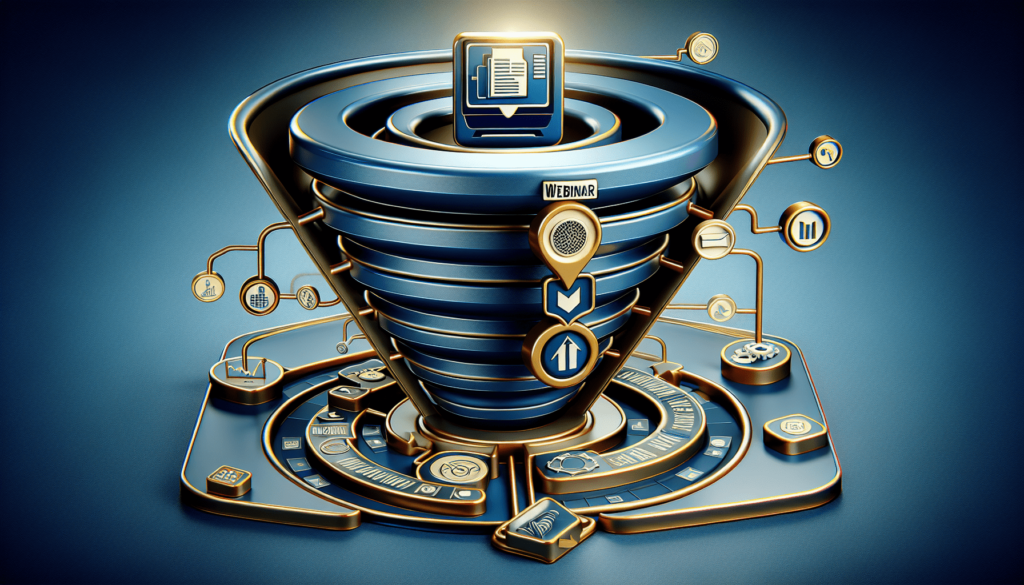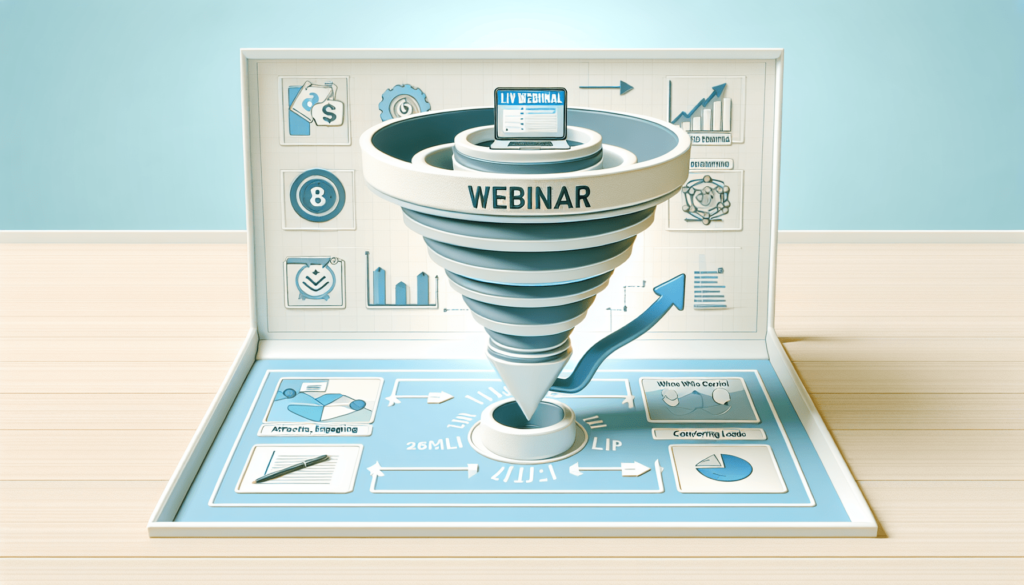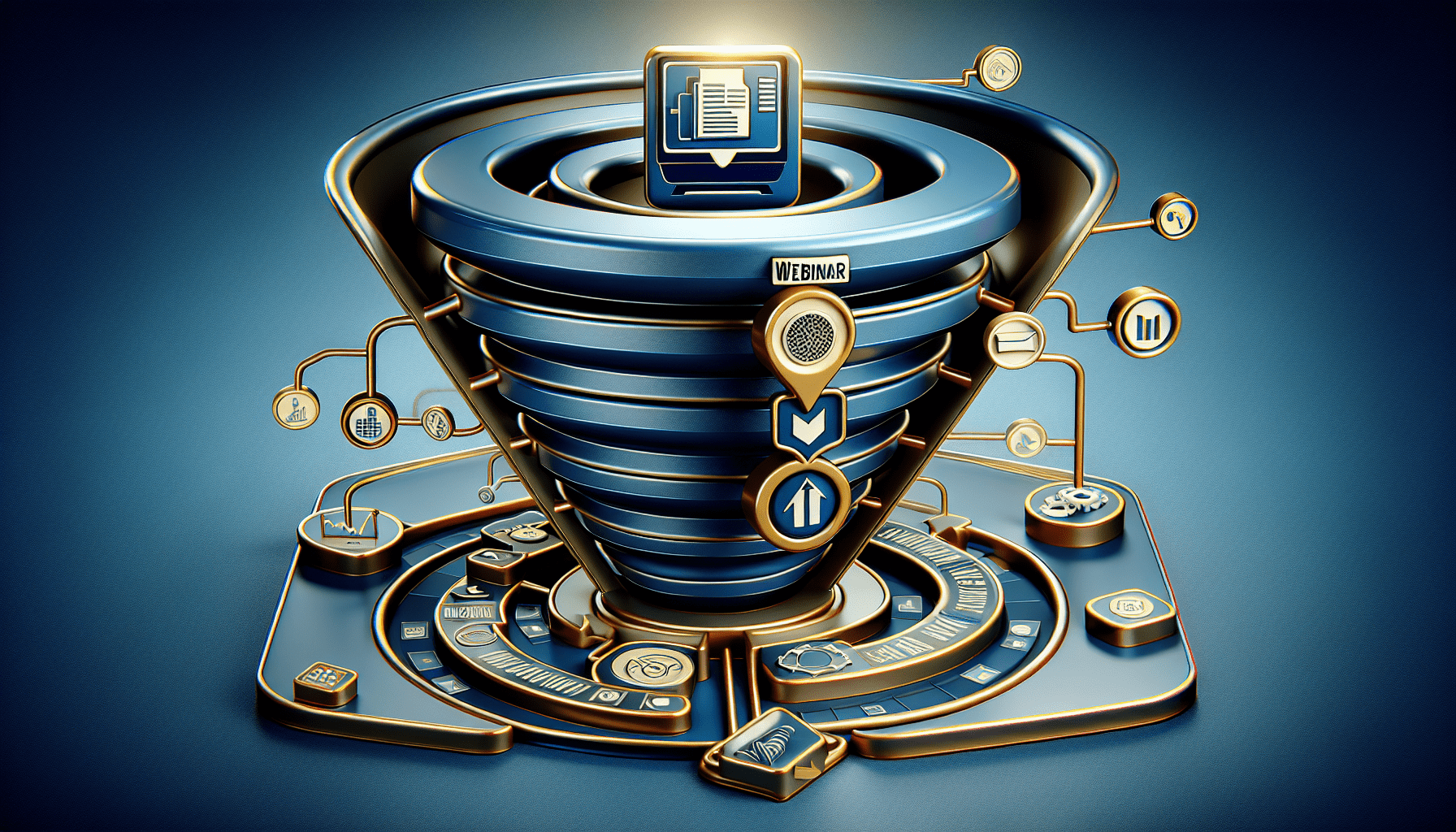Imagine having a powerful tool in your sales arsenal that not only educates and engages potential customers but also increases conversions and boosts sales. That’s where webinars come in. With their interactive format and ability to reach a wide audience, webinars have become a game-changer for businesses. In this article, we’ll explore how you can effectively leverage webinars in your sales funnel to captivate your audience, nurture leads, and ultimately drive more revenue to your business. Get ready to discover the secrets of webinar success and take your sales to new heights.
Understanding the Sales Funnel
Definition of a sales funnel
A sales funnel refers to the buying process that companies lead customers through when purchasing products or services. It is a visual representation of the journey a prospect takes, starting from the awareness stage and eventually reaching the decision stage. The funnel metaphor is used because, at each stage, the number of potential customers decreases as some drop out or are filtered out, leaving only those who are truly interested in making a purchase.
Stages of the sales funnel
The sales funnel can be divided into several stages, each representing a different level of customer engagement. The four main stages are “awareness,” “consideration,” “decision,” and “loyalty.”
-
Awareness: At this stage, potential customers become aware of a company’s brand or products through various channels, such as social media, advertisements, or word-of-mouth recommendations.
-
Consideration: Once prospects are aware of a company, they move to the consideration stage. Here, they actively evaluate the products or services offered, comparing them with competitors and looking for the most suitable solution to meet their needs.
-
Decision: In the decision stage, prospects are ready to make a purchase decision. They have narrowed down their options and are looking for the final push to convert them into customers.
-
Loyalty: After making a purchase, customers enter the loyalty stage. This stage focuses on building long-term relationships with customers, encouraging repeat purchases, and fostering brand advocacy.
Importance of a sales funnel
A well-designed sales funnel is essential for business success because it helps companies guide potential customers through each stage of the buying process. By understanding the sales funnel, businesses can effectively optimize their marketing strategies and sales efforts to convert leads into customers.
Without a clear understanding of the sales funnel, businesses risk losing potential customers at various stages of the buyer’s journey. Implementing a sales funnel allows businesses to identify areas for improvement, optimize their marketing campaigns, and provide a seamless experience for their target audience.
What is a Webinar?
Definition of a webinar
A webinar is a live or pre-recorded seminar or workshop that is conducted over the internet. It provides an interactive platform for businesses to connect with their target audience, share valuable information, and engage in real-time discussions. Webinars typically include features such as presentations, slideshows, videos, and live chats, allowing participants to actively participate and ask questions.
Benefits of using webinars
Webinars offer several benefits for businesses looking to engage and convert their audience:
-
Increased Reach: By hosting a webinar, businesses can reach a wider audience as participants can join from anywhere in the world, eliminating geographical limitations.
-
Cost-effective: Compared to traditional in-person seminars or conferences, webinars are a cost-effective solution. They save on travel expenses, venue rentals, and other logistical costs.
-
Educational Platform: Webinars provide an opportunity for businesses to educate their target audience about their products, industry trends, and other relevant topics. It positions the business as an authority in the industry and builds trust with potential customers.
-
Lead Generation: Webinars are excellent lead generation tools. Participants are required to register and provide contact information, allowing businesses to follow up and nurture those leads further down the sales funnel.
Types of webinars
There are different types of webinars that businesses can utilize, depending on their goals and target audience:
-
Educational Webinars: These webinars focus on providing valuable information and educating participants about a specific topic related to the industry or the company’s products. It helps generate interest and establish credibility.
-
Product Demonstrations: Product demonstration webinars showcase the features, benefits, and functionalities of a company’s products or services. It allows potential customers to see how the products can solve their problems or meet their needs.
-
Comparison Webinars: Comparison webinars highlight the differences between a company’s own products and those of its competitors. It helps potential customers make an informed decision by comparing the features and benefits of different options.
-
Expert Panel Discussions: Expert panel discussions are webinars that bring together industry experts to discuss relevant topics and share their insights. These webinars provide participants with valuable knowledge and different perspectives from experts in the field.

Integration of Webinars in the Sales Funnel
When it comes to integrating webinars into the sales funnel, it is essential to align the webinar content with each stage of the buyer’s journey. By doing so, businesses can effectively engage potential customers and guide them through the sales funnel towards making a purchase decision.
Awareness stage
In the awareness stage, businesses can leverage webinars to attract leads and generate interest in their brand or products. Educational webinars are a great way to provide valuable information and establish credibility. By offering free educational content, participants are more likely to engage with the company and move forward in the sales funnel.
Additionally, webinars can serve as an introduction to a brand and its products. By showcasing the unique value proposition and highlighting how the products can solve potential customers’ pain points, businesses can capture the attention of the target audience and create brand awareness.
Consideration stage
In the consideration stage, potential customers are actively evaluating different options and comparing them to find the best solution. Webinars can play a crucial role here by providing product demonstrations and showcasing the features and benefits of a company’s products or services.
Product demonstration webinars allow participants to see the products in action and understand how they can address their specific needs. Businesses can highlight the unique selling points and competitive advantages of their offerings, helping participants make an informed decision.
Comparison webinars are also effective in the consideration stage. These webinars compare a company’s products with those of its competitors, highlighting the key differences and advantages. By presenting a compelling case and demonstrating why their products are superior, businesses can sway potential customers towards their offerings.
Expert panel discussions can also be valuable in the consideration stage. By bringing together industry experts to discuss relevant topics, participants can gain valuable insights and expert opinions. This can help them evaluate various options and make an informed decision.
Decision stage
The decision stage is the final step in the sales funnel, where potential customers are ready to make a purchasing decision. Webinars in this stage can provide the final push needed to convert leads into customers.
Exclusive offers, discounts, or bonuses can be presented to webinar attendees to incentivize them to make a purchase. By offering limited-time promotions or exclusive deals, businesses can create a sense of urgency and encourage immediate action.
Q&A sessions can also be conducted to address any doubts or concerns potential customers may have before making a decision. This interactive format allows participants to get direct answers and build trust in the company’s offerings.
Furthermore, businesses can provide limited-time discounts or bonuses to webinar attendees, further incentivizing them to make a purchase. By giving participants a sense of exclusivity and added value, the decision to buy becomes more compelling.
Promoting Webinars for Maximum Impact
Hosting a webinar is just the first step. To ensure maximum impact, businesses need to effectively promote their webinars to reach their target audience and generate interest. Here are some strategies for promoting webinars:
Utilizing email marketing
Email marketing is a powerful tool for promoting webinars. By creating targeted email campaigns, businesses can reach out to their existing contact list and raise awareness about the upcoming webinar. Emails should clearly highlight the value and benefits of attending the webinar, encouraging recipients to register and participate.
Businesses can also collaborate with industry influencers or experts who have relevant email lists. By partnering with these influencers, companies can promote the webinar to a wider audience and benefit from their credibility and reach.
Leveraging social media platforms
Social media platforms are ideal for promoting webinars due to their widespread reach and engagement capabilities. By creating engaging and compelling posts, businesses can generate buzz around the webinar and increase registration.
Posting teaser content, sharing behind-the-scenes moments, and highlighting the value participants will receive can help create anticipation and generate interest. Additionally, businesses can leverage social media advertising to target a specific audience and maximize webinar reach.
Partnering with influencers or industry experts
Collaborating with influencers or industry experts can significantly enhance webinar promotion efforts. By leveraging the influencers’ large following and credibility, businesses can tap into new audiences and generate more registrations.
Influencers can promote the webinar through sponsored content, live Q&A sessions, or social media takeovers. Their endorsement and personal experiences can generate trust and interest among their followers, driving more participants to the webinar.

Effective Webinar Strategies
To make the most out of webinars, businesses should implement effective strategies to ensure high engagement and a positive participant experience. Here are some essential strategies for conducting successful webinars:
Planning a compelling agenda
A well-planned and structured agenda is crucial for a productive and engaging webinar. It is essential to outline the key topics, set clear objectives, and identify the target audience’s pain points. This helps create a webinar that is focused, informative, and resonates with the attendees.
Creating an outline and script for the webinar ensures a smooth flow of content and minimizes any potential confusion or disorganization. Additionally, incorporating interactive elements, such as polls or quizzes, can keep participants engaged and provide valuable insights for businesses.
Engaging and interactive presentation style
To capture and retain participants’ attention, it is important to present the webinar in an engaging and interactive manner. Presenters should adopt a conversational tone and use storytelling techniques to make the content relatable and memorable.
Encouraging active participation through live chats, Q&A sessions, or interactive polls can enhance the overall participant experience. This allows attendees to contribute, ask questions, and feel involved in the webinar.
Using high-quality visuals and multimedia
Visual aids play a pivotal role in webinars by enhancing understanding and retention. Incorporating high-quality visuals, such as slides, infographics, or videos, can effectively convey information and keep participants visually engaged.
Using multimedia elements, such as videos or animations, can further enhance the webinar experience. These elements break the monotony of a presentation and add an extra layer of interest and interactivity.
Measuring Webinar Success
To gauge the effectiveness of webinars, it is essential to measure key metrics and evaluate the impact on overall business goals. Here are some ways to measure webinar success:
Tracking registration and attendance rates
The number of registrations and actual attendees is a tangible measure of a webinar’s reach and appeal. High registration rates indicate strong interest, while high attendance rates reflect participant engagement.
By comparing registration and attendance rates, businesses can identify areas for improvement and optimize future webinar promotions and content.
Evaluating engagement metrics
Engagement metrics provide insights into how participants interact with the webinar content. Metrics such as average viewing time, questions asked, and polls answered can indicate participant engagement levels and overall satisfaction.
Analyzing engagement metrics helps businesses understand the effectiveness of their webinar strategies and identify areas for improvement.
Analyzing conversion rates
Conversion rates measure the percentage of webinar participants who take a desired action, such as making a purchase or signing up for a service. This metric indicates the webinar’s impact on the sales funnel and the effectiveness of the content presented.
Analyzing conversion rates provides valuable insights into the webinar’s ability to convert leads into customers and optimize future sales strategies.
Continuous Improvement and Optimization
Webinars are not a one-time effort; they require continuous improvement and optimization to maximize their effectiveness. Here are some strategies for continuous improvement:
Collecting attendee feedback
Collecting feedback from webinar attendees allows businesses to gain valuable insights and understand the participants’ perspective. Feedback can be obtained through post-webinar surveys or by encouraging participants to provide comments or suggestions during the webinar.
By analyzing attendee feedback, businesses can identify areas of improvement and make necessary adjustments for future webinars.
Testing different webinar formats
Exploring different webinar formats allows businesses to identify the most effective approach for engaging their target audience. This can include experimenting with different presentation styles, interactive elements, or guest speakers.
Testing different formats allows businesses to gather data on participant engagement and optimize their webinar strategies accordingly.
Iterating on the sales funnel based on analytics
Analyzing webinar data and metrics can provide valuable insights into the sales funnel’s effectiveness. By correlating the impact of webinars on lead generation, conversion rates, and customer satisfaction, businesses can make data-driven decisions to optimize their sales funnel.
Iterating on the sales funnel based on analytics allows businesses to align the webinar strategies with the evolving needs and preferences of their target audience.
In conclusion, webinars offer a powerful tool for integrating into the sales funnel, from generating awareness to nurturing leads and driving conversions. By understanding the sales funnel, leveraging the benefits of webinars, and implementing effective strategies, businesses can harness the full potential of webinars to engage and convert their target audience. Continuous improvement and optimization ensure that webinars remain an impactful and valuable asset in the sales and marketing efforts of businesses.

